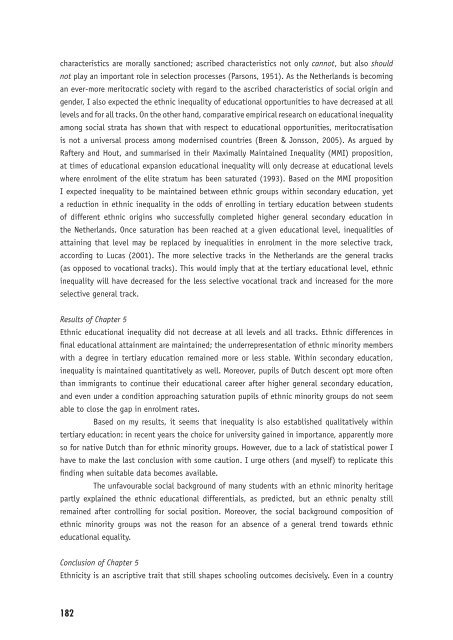Ethnic Hostility among Ethnic Majority and Minority Groups
Ethnic Hostility among Ethnic Majority and Minority Groups
Ethnic Hostility among Ethnic Majority and Minority Groups
You also want an ePaper? Increase the reach of your titles
YUMPU automatically turns print PDFs into web optimized ePapers that Google loves.
characteristics are morally sanctioned; ascribed characteristics not only cannot, but also should<br />
not play an important role in selection processes (Parsons, 1951). As the Netherl<strong>and</strong>s is becoming<br />
an ever-more meritocratic society with regard to the ascribed characteristics of social origin <strong>and</strong><br />
gender, I also expected the ethnic inequality of educational opportunities to have decreased at all<br />
levels <strong>and</strong> for all tracks. On the other h<strong>and</strong>, comparative empirical research on educational inequality<br />
<strong>among</strong> social strata has shown that with respect to educational opportunities, meritocratisation<br />
is not a universal process <strong>among</strong> modernised countries (Breen & Jonsson, 2005). As argued by<br />
Raftery <strong>and</strong> Hout, <strong>and</strong> summarised in their Maximally Maintained Inequality (MMI) proposition,<br />
at times of educational expansion educational inequality will only decrease at educational levels<br />
where enrolment of the elite stratum has been saturated (1993). Based on the MMI proposition<br />
I expected inequality to be maintained between ethnic groups within secondary education, yet<br />
a reduction in ethnic inequality in the odds of enrolling in tertiary education between students<br />
of different ethnic origins who successfully completed higher general secondary education in<br />
the Netherl<strong>and</strong>s. Once saturation has been reached at a given educational level, inequalities of<br />
attaining that level may be replaced by inequalities in enrolment in the more selective track,<br />
according to Lucas (2001). The more selective tracks in the Netherl<strong>and</strong>s are the general tracks<br />
(as opposed to vocational tracks). This would imply that at the tertiary educational level, ethnic<br />
inequality will have decreased for the less selective vocational track <strong>and</strong> increased for the more<br />
selective general track.<br />
Results of Chapter 5<br />
<strong>Ethnic</strong> educational inequality did not decrease at all levels <strong>and</strong> all tracks. <strong>Ethnic</strong> differences in<br />
fi nal educational attainment are maintained; the underrepresentation of ethnic minority members<br />
with a degree in tertiary education remained more or less stable. Within secondary education,<br />
inequality is maintained quantitatively as well. Moreover, pupils of Dutch descent opt more often<br />
than immigrants to continue their educational career after higher general secondary education,<br />
<strong>and</strong> even under a condition approaching saturation pupils of ethnic minority groups do not seem<br />
able to close the gap in enrolment rates.<br />
Based on my results, it seems that inequality is also established qualitatively within<br />
tertiary education: in recent years the choice for university gained in importance, apparently more<br />
so for native Dutch than for ethnic minority groups. However, due to a lack of statistical power I<br />
have to make the last conclusion with some caution. I urge others (<strong>and</strong> myself) to replicate this<br />
fi nding when suitable data becomes available.<br />
The unfavourable social background of many students with an ethnic minority heritage<br />
partly explained the ethnic educational differentials, as predicted, but an ethnic penalty still<br />
remained after controlling for social position. Moreover, the social background composition of<br />
ethnic minority groups was not the reason for an absence of a general trend towards ethnic<br />
educational equality.<br />
Conclusion of Chapter 5<br />
<strong>Ethnic</strong>ity is an ascriptive trait that still shapes schooling outcomes decisively. Even in a country<br />
182












